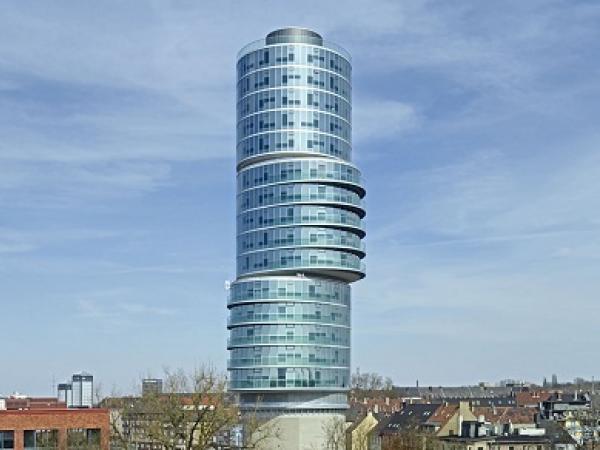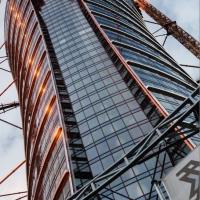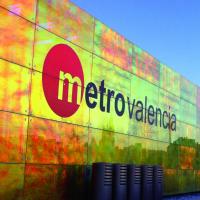Deploying highly functional glass products and integrating energy-relevant products are effective ways to achieve optimum efficiency even in large-format glass façades.
Façades have long moved beyond being just static shells providing weather protection at the interface of building interior and exterior. With good reason, they’re often compared to human skin, which indeed does have a protective role to play, but also adjusts dynamically to external conditions and thus maintains the body’s “ideal temperature.”
Modern glass façades are tasked with exactly this function – except in relation to indoor climatic conditions. In light of significantly tightened energy efficiency standards for buildings, the building envelope must play yet another crucial role in achieving a reduced primary energy demand: Heating, air-conditioning and lighting are among the most power-hungry systems in office buildings. And the façade can directly influence these consumption factors. The goal must be to optimise thermal insulation, protect interior spaces from overheating, ventilate rooms in a controlled manner, use daylight to the fullest extent possible and minimise the use of supplementary air-conditioning.
Keeping pace with ever higher expectations, façade technology has been systematically improved in years past. One target pursued in this development process is the multifunctional adaptive façade, a shell that’s able to respond dynamically to changing environmental conditions. Glass façades hold great potential in this area. Decentralised controls for ventilation, heating and cooling via the building envelope enable significant building technology reductions. At the same time, integration with building automation systems ensures that individual components can work together in perfect unison to achieve maximum energy efficiency.
Photo 1 - Opened in January of 2014 at 3,048 metres above sea level on top of Gaislachkogel peak in Sölden, Austria, the design restaurant “Ice Q” serves as a prime example for contemporary glass architecture right in the High Alps. The 900 m2 glass façade with its high-performance triple-pane insulation glass was designed and built by the Austrian façade specialist GIG Fassaden GmbH. Photo: GIG Fassaden
Efficient combination of components
Even today, the components needed for the multifunctional façade of the future are already widely available. The challenge, then, for architects, façade designers and façade manufacturers generally lies in the optimisation of existing systems and in the individualised, demand-oriented integration and combination of available technologies and products. Ambitious targets have been set.
In Europe, for example, the “Energy Performance of Buildings Directive” (EPBD 2010) stipulates that all new buildings in EU member states must be constructed as “nearly zero-energy buildings” from 2020 onwards. This high bar can only be cleared by using highly efficient façades that provide excellent insulation and smart indoor climate control – all while harnessing the power of the sun.
Photo 2 - The Schüco E² Façade is an energy-efficient complete system that unites façade and system technology. Customised solution packages can be created thanks to its four function modules (decentralised ventilation, façade-integrated photovoltaics, façade-integrated solar shading and integrated opening units). Photo: Schüco
Optimised system technology
The deployment of highly efficient, variable-use façade systems is a prerequisite for the creation of energy-efficient glass façades. Therefore, system providers aim at further improving the insulating performance and application flexibility of their profile systems. Improved profile geometries and the creation of the preconditions for the use of high-performance triple insulating units are important aspects in this regard.
Despite significant progress, large-format glass façades continue to be left behind, when it comes to heat transfer properties, by classic perforated façades with insulation. At the same time, however, they also offer numerous advantages over solid construction. Thanks to copious amounts of glass used, they allow for visual contact with the outside world. What’s more, they create enhanced lighting possibilities and ideal conditions for solar gain.
The E2 Façade by Schüco illustrates just how far system technology has progressed in the direction of multifunctional glass façades. It’s an energy-efficient complete system with a revolutionary combination of façade and system technology that both saves and generates energy. Customised solution packages can be created thanks to its four function modules (decentralised ventilation, façade-integrated photovoltaics, façade-integrated solar shading and integrated opening units)
Photo 3 - Today’s argon-filled and Low-E-coated triple-pane insulation glass can reach Ug values of up to 0.6 W/m2K. In order to achieve optimum thermal insulation, it is necessary to deploy modern warm-edge seal systems such as the spacers made by Swisspacer. Combining a highly insulating profile consisting of plastic composite materials, a gas-tight foil and desiccants as filling materials, the spacer system minimises heat loss and ensures long-lasting serviceability of the insulation glass by. Photo: Swisspacer
High-performance functional glass
The use of safety glass brings to the fore the extensive structural possibilities and design advantages offered by glass (curved glass, screen printing, digital printing, enamelling etc.) and thus provides considerable flexibility in the design of customised high-performance glass façades. However, large glass surfaces also allow for outside conditions to strongly impact the indoor climate. As a result, the functionality of glass products used is of considerable importance.
Excellent results are possible nowadays with high-performance thermal- and solar-control glass. For example, double-pane insulating glass filled with the noble gas argon and used with warm-edge spacer systems currently achieves a thermal transmittance value of around 1.0 W/m2K.
This value drops to 0.6 W/m2K for triple-pane insulating glass used in standard configurations. Even 0.5 W/m2K is possible if the space between panes is increased. Even lower thermal transmittance values are possible in today’s standard glass configurations by using the ultra-expensive noble gas krypton.
Another option exists for pushing down even further the thermal transmittance coefficient while using argon – quad-pane insulating glass. Even though these products achieve a U-value of 0.3 W/m2K, they’re not any heavier than conventional triple-pane glass because they’re made using hardened thin glass.
Another option, vacuum insulated glass (VIG), would make stacking window panes an easier-to-manage task for window and façade manufacturers. Glass of this kind is already available in Asian markets, but despite focussed research efforts, Europe is still waiting to see equivalent products for façade applications become ready for mass production.
Photo 4 - The triple-pane solar control glass ipasol neutral by AGC Interpane delivers excellent thermal insulation and ideal protection from the sun in this office building, which is superimposed upon an air-raid shelter in Bochum, Germany. Partially coating the glazing with ipachrome design helps to provide additional glare and solar control, especially on the building’s south-facing side. Photo: Fotodesign Andreas Braun, AGC Interpane
Solar control and light directing
Besides heat insulation, large-format façades must also master the challenge of providing reliable solar and glare protection. Solar control glass alone – while efficient and easy to integrate – is often not sufficient to reliably prevent undesirable heat gain in interior spaces during the summer. Alternatives to shading systems installed on the inside or outside of the façade are available, including special solar control glass featuring electric voltage-based automatic tinting to minimise the impact of sunlight.
In autumn of 2013, the University of Giessen presented an intriguing development in this area. Led by Prof. Bruno Meyer, the Physical Institute there developed and filed a patent application for an energy-efficient glass coating that allows for temperature-dependent thermal transmittance. Using this passive (i.e. non-voltage), transparent glass coating allows for the straightforward control of sun-induced heat gain in interior spaces. At 20 degrees Celsius, the material autonomously switches from semiconductor (permeable to light) to metal (reflective).1
Insulation glass with integrated solar and/or light directing control is another frequently used alternative. These systems are integrated into the glass and can be controlled manually or electronically to align with individual insolation and light conditions. Thanks to integrated slats with variable adjustment angles, daylight can be directed into the interior of the room.
The Austrian company Eckelt Glass offers DLS Ecklite Evolution, for example, an insulation glass product with two separate, electrically driven louvre blinds integrated into the glass, featuring a concave section for active light directing in the upper part of the glass and a convex section for efficient solar and glare control in the vision area.
Depending on exterior lighting conditions, users can choose to open either the vision area only or both the vision area and the upper area for an unobstructed view. Other effective solutions for targeted daylighting and balanced illumination of rooms besides these louvre systems include glazing with engraved louvre structures, rigidly mounted reflective blinds and integrated prism structures.
Photos 5a, 5b - The synergy of active light directing and variable solar control in insulating glass: DLS Ecklite Evolution by the Austrian company Eckelt Glas integrates two separate, electrically driven louvre blinds in the cavity and features a concave section for active light directing in the upper part of the glass and a convex section for efficient solar and glare control in the vision area. If desired, the blinds can be opened completely, either only in the vision area or both in the vision and upper area for an unobstructed view. In the triple-pane configuration, a thermal insulation value of up to 0.6 W/m²K is possible. Photos: Eckelt Glas
Energy from the façade
Seeing that the amount of available solar energy is 3,000 times greater than total global energy consumption, it would seem smart to harness the sun to generate eco-friendly energy right in the façade. Photovoltaic modules can be incorporated in nearly any kind of glass installation.
Solutions with integrated PV can easily be implemented even with multi-pane insulating glass with thermal and acoustic protection properties and with overhead and walkable glass. Set up correctly, the solar control functionality of a PV façade can even make additional shading systems obsolete. Moreover, solar energy from collector systems integrated into the façade can be used for heat production.
glasstec 2014 in Düsseldorf will show just how innovative the glass industry really is, including in this market segment, what product solutions the sector has in store to help make glass façades more energy efficient and how architects and façade builders envision the future.
From 21 to 24 October, the leading international trade fair of the glass industry will present the latest developments revolving around the energy-efficient building envelope at the trade fair stands, the special show “glass technology live” and the Façade Center. This range of offerings is further enhanced by the scientific conference “engineered transparency,” which focusses on “Glass Construction,” from 21 – 22 October 2014 and by the International Architecture Congress, entitled “Glass 5.0 – Design, Function, Emotion,” on 22 October 2014.
The building envelope as multiplayer
Thanks to continuous construction, technology and product advancements, plenty of development potential remains for large-format glass façades. Regardless of any temporary façade design trends, topics such as energy efficiency and improvement of indoor climatic conditions will dominate architecture and façade construction in future, with additional attention paid to the sustainability of materials and products used.
Stronger multi-disciplinary cooperation will be critical on the path to energy-optimised glass façades and buildings. “Architects, engineers, builders and façade specialists must and will aim to meet political imperatives regarding the optimisation of energy consumption, without neglecting architectural and quality-related aspects or ecological and economic considerations.
The building envelope turns into a ‘multi-player’ with the ability to coordinate and control light, air and energy flows simultaneously,” says Rudolf Locher, the Managing Director of the Swiss Centre for Windows and Façades (SZFF) in summarising the future challenges awaiting façade professionals.²
Bibliography
1 Gesellschaft für Technologietransfer mbH, Holger Mauelshagen,
www.transmit.de
2 TEC21, 28/29th edition 2009, pp. 16-20
Press Contact glasstec 2014
Sebastian Pflügge
Brigitte Küppers (Assistant)
Tel.: +49(0)211/4560-464 or -929
Fax: +49(0)211/4560-87 464
E-Mail: PflueggeS@messe-duesseldorf.de or
KueppersB@messe-duesseldorf.de























